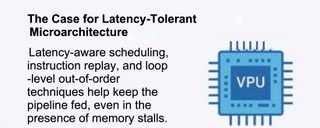Key Takeaways
- High Bandwidth Memory (HBM) is crucial for modern AI accelerators, enabling high data retrieval rates.
- Despite HBM's high bandwidth, latency remains a significant issue, causing performance bottlenecks.
- AI processors depend on synchronized data flow, and delays can stall numerous operations, impacting performance.

Why Latency-Tolerant Architectures Matter in the Age of AI Supercomputing
High Bandwidth Memory (HBM) has become the defining enabler of modern AI accelerators. From NVIDIA’s GB200 Ultra to AMD’s MI400, every new AI chip boasts faster and larger stacks of HBM, pushing memory bandwidth into the terabytes-per-second range. But beneath the impressive specs lies a less obvious truth: even HBM isn’t fast enough all the time. And for AI hardware designers, that insight could be the key to unlocking real performance.
The Hidden Bottleneck: Latency vs Bandwidth
HBM solves one side of the memory problem—bandwidth. It enables thousands of parallel cores to retrieve data from memory without overwhelming traditional buses. However, bandwidth is not the same as latency.
Even with terabytes per second of bandwidth available, individual memory transactions can still suffer from delays. A single miss in a load queue might cost dozens of clock cycles. The irregular access patterns typical of attention layers or sparse matrix operations often disrupt predictive mechanisms like prefetching. In many systems, memory is shared across multiple compute tiles or chiplets, introducing coordination and queuing delays that HBM can’t eliminate. And despite the vertically stacked nature of HBM, DRAM row conflicts and scheduling contention still occur.
In aggregate, these latency events create performance cliffs. While the memory system may be technically fast, it’s not always fast enough in the precise moment a compute engine needs data—leading to idle cycles in the very units that make these chips valuable.
Vector Cores Don’t Like to Wait
AI processors, particularly those optimized for vector and matrix computation, are deeply dependent on synchronized data flow. When a delay occurs—whether due to memory access, register unavailability, or data hazards—entire vector lanes can stall. A brief delay in data arrival can halt hundreds or even thousands of operations in flight.
This reality turns latency into a silent killer of performance. While increasing HBM bandwidth can help, it’s not sufficient. What today’s architectures truly need is a way to tolerate latency—not merely race ahead of it.
The Case for Latency-Tolerant Microarchitecture
Simplex Micro, a patent-rich startup based in Austin, has taken on this challenge head-on. Its suite of granted patents focuses on latency-aware instruction scheduling and pipeline recovery, offering mechanisms to keep compute engines productive even when data delivery lags.

Among their innovations is a time-aware register scoreboard, which tracks expected load latencies and schedules operations accordingly avoiding data hazards before they occur. Another key invention enables zero-overhead instruction replay, allowing instructions delayed by memory access to reissue cleanly and resume without pipeline disruption. Additionally, Simplex has introduced loop-level out-of-order execution, enabling independent loop iterations to proceed as soon as their data dependencies are met, rather than being held back by artificial order constraints.
Together, these technologies form a microarchitectural toolkit that keeps vector units fed and active—even in the face of real-world memory unpredictability.
Why It Matters for Hyperscalers
The implications of this design philosophy are especially relevant for companies building custom AI silicon—like Google’s TPU, Meta’s MTIA, and Amazon’s Trainium. While NVIDIA has pushed the envelope on HBM capacity and packaging, many hyperscalers face stricter constraints around power, die area, and system cost. For them, scaling up memory may not be a sustainable strategy.
This makes latency-tolerant architecture not just a performance booster, but a practical necessity. By improving memory utilization and compute efficiency, these innovations allow hyperscalers to extract more performance from each HBM stack, enhance power efficiency, and maintain competitiveness without massive increases in silicon cost or thermal overhead.
The Future: Smarter, Not Just Bigger
As AI workloads continue to grow in complexity and scale, the industry is rightly investing in higher-performance memory systems. But it’s increasingly clear that raw memory bandwidth alone won’t solve everything. The real competitive edge will come from architectural intelligence—the ability to keep vector engines productive even when memory stalls occur.
Latency-tolerant compute design is the missing link between cutting-edge memory technology and real-world performance. And in the race toward efficient, scalable AI infrastructure, the winners will be those who optimize smarter—not just build bigger.
Also Read:
RISC-V’s Privileged Spec and Architectural Advances Achieve Security Parity with Proprietary ISAs
Harnessing Modular Vector Processing for Scalable, Power-Efficient AI Acceleration
An Open-Source Approach to Developing a RISC-V Chip with XiangShan and Mulan PSL v2
Share this post via:





Jensen Huang Drops Donald Trump Truth Bomb on Joe Rogan Podcast